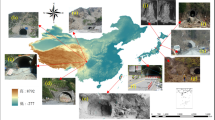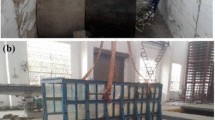Abstract
With more and more the transportation tunnels that have been and will be constructed in loess areas in Northwest China with high earthquake potential, the overall stability of tunnel portal sections under earthquake action and the related aseismic countermeasures has attracted the attention of both scholars and engineers, especially for tunnels in upper slope connecting high bridges crossing rivers or valleys. To study the dynamic response characteristics and damage evolution of steep loess slopes with tunnels under earthquake action, large-scale shaking table tests and numerical simulations were performed on steep loess slopes with tunnels. In particular, three-dimensional noncontact optical measurement techniques were used to obtain the slope surface displacements. The results showed that the main deformation patterns of the studied slopes were horizontal movement and settlement when the seismic waves were input in the X and X–Z directions, respectively. However, the seismic wave from the X direction had a greater impact on the deformation of a slope than that from the X–Z direction, and the tunnel portal slopes were ultimately destroyed under the action of a large horizontal seismic acceleration. Slope failure ahead of a tunnel was divided into four stages, i.e., the elastic deformation stage, plastic deformation accumulation stage, local failure stage, and overall failure stage. The existence of the tunnel had a great influence on the peak ground acceleration (PGA) and the PGA amplification factor (PGAAF) of the surrounding soil mass. The changes in the PGD and PGA on the slope surface determined via numerical simulation were basically consistent with the experimental results.














Similar content being viewed by others
References
Asakura T, Shiba Y, Matsuoka S, Oya T, Yashiro K (2000) Damage to mountain tunnels by earthquake and its mechanism. Doboku Gakkai Ronbunshu 659:27–38
Bian L, Liang QG, Zhang QP (2018) Experimental study on seismic responses of slope and portal of loess tunnel. Railway Stand Des 62(3):79–84
Bouckovalas GD, Papadimitriou AG (2005) Numerical evaluation of slope topography effects on seismic ground motion. Soil Dyn Earthq Eng 25(7–10):547–558
Carey JM, McSaveney MJ, Petley DN (2017) Dynamic liquefaction of shear zones in intact loess during simulated earthquake loading. Landslides 14(3):789–804
Chang WB, Wang P, Wang HJ, Chai SF, Yu YF, Xu SY (2021) Simulation of the Q2 loess slope with seepage fissure failure and seismic response via discrete element method. Bull Eng Geol Environ 80(4):3495–3511
Cui GY, Wang MN, Lin GJ, Wang WJ, Zhang D (2011) Statistical analysis of earthquake damage types of typical highway tunnel lining structure in Wenchuan seismic disastrous area. Chin J Geol Haz Control 22(1):122–127
Danneels G, Bourdeau C, Torgoev I, Havenith HB (2008) Geophysical investigation and dynamic modelling of unstable slopes: case-study of Kainama (Kyrgyzstan). Geophys J Int 175(1):17–34
Deng J, Wang LM, Zhang ZZ, Bing H (2010) Microstructure characteristics and forming environment of late Quaternary Period loess in the Loess Plateau of China. Environ Earth Sci 59(8):1807–1817
Dong CX, Duan Z, Li RW, Li JS, Li H, Wang NQ, Peng JB, Chen X (2023) Impact liquefaction mechanism of sandy silt with a change in impact energy. Q J Eng Geol Hydroge 56(3):1–11
Fang J, Liang QG, Zhang QP, He P, Wang LL (2018) Numerical simulation of dynamic responses of loess tunnel portal section with the consideration of tunneling elevation on the slope. Earthq Eng Eng Dyn 38(3):152–161
Gao B, Wang SS, Wang YX, Shen YS (2016) Aseismic study on mountain tunnels in high-intensity seismic area. Proceedings of the 2nd Czech-China Scientific Conference Chapter 28:329–344
Hashash YMA, Hook JJ, Schmidt B, Yao JI-C (2001) Seismic design and analysis of underground structures. Tunn Undergr Sp Tech 16(4):247–293
Kazmi ZA (2013) Extraction of Lagrangian ground displacements and subsurface seismic stress changes for rational earthquake disaster mitigation. University of Tokyo, Tokyo
Khalajzadeh AK, Choobbasti AJ, Kutanaei SS (2023) Dynamic behavior of an earth slope, including a tunnel structure. Soil Dyn Earthq Eng 172:108038
Liang QG, Bian L, Zhang QP, Huang J, Wang M (2018) Study on seismic dynamic characteristics of large section loess tunnel portal. J Highway Transport Res Dev 35(7):65–76
Lin ML, Wang KL (2006) Seismic slope behavior in a large-scale shaking table model test. Eng Geol 86(2):118–133
Liu DS (1985) Loess and the environment. China Ocean Press, Beijing
Liu YR, He Z, Leng KD, Huang YQ, Yang Q (2013) Dynamic limit equilibrium analysis of sliding block for rock slope based on nonlinear FEM. J Cent South Univ 20(8):2263–2274
Niu JY, Jiang XL, Wang FF, Yang H (2019) Comparative analysis of dynamic responses of different rock tunnel slopes. Geotech Geol Eng 38(5):1409–1430
Pu XW, Wang LM, Wang P (2021) Initiation mechanism of mudflow-like loess landslide induced by the combined effect of earthquakes and rainfall. Nat Hazards 105(3):3079–3097
Qin YW, Chen YH, Lai JX, Qiu JL, Wang ZC, Liu T, Zan WB (2024) Failures in loess slope-tunnel system: An overview of trigging sources, acting mechanism and mitigation strategies. Eng Fail Anal 158:107996
Song DQ, Che AL, Zhu RJ, Ge XR (2017) Dynamic response characteristics of a rock slope with discontinuous joints under the combined action of earthquakes and rapid water drawdown. Landslides 15(6):1109–1125
Sun WY, Yan SH, Ma QG, Liang QG, Ou EF, Cao XP, Wang JH, Luo XX (2021) Dynamic response characteristics and failure mode of a bias loess tunnel using a shaking table model test. Transp Geotech 31(11):100659
Tang HM, Jia HB, Hu XL, Li DW, Xiong CR (2010) Characteristics of landslides induced by the great Wenchuan earthquake. J Earth Sci-China 21(1):104–113
Tao H, Zhang MM, Gong L, Shi X, Wang YJ, Yang GQ, Lei SW (2022) The mechanism of slope instability due to rainfall-induced structural decay of earthquake-damaged loess. Earthq Res Adv 2(3):49–57
Wang KL, Lin ML (2011) Initiation and displacement of landslide induced by earthquake - a study of shaking table model slope test. Eng Geol 122(1–2):106–114
Wang SS, Gao B, Sui CY, Wen YM (2014) Shaking table test for seismic behavior of upward slope at tunnel entrance in different geological conditions. Rock Soil Mech 35(S1):278–284
Wang JD, Li P, Gu Q, Xu YJ, Gu TF (2018a) Changes in tensile strength and microstructure of loess due to vibration. J Asian Earth Sci 169:298–307
Wang LM, Pu XW, Wu ZJ, Xu SH, Liu K (2018b) Shaking table tests on dynamic response of loess slopes under coupling effects of earthquakes and rainfalls. Chin J Geotech Eng 40(7):1287–1293
Wang LM, Wu ZJ, Xia K, Liu K, Wang P, Pu XW, Li L (2019a) Amplification of thickness and topography of loess deposit on seismic ground motion and its seismic design methods. Soil Dyn Earthq Eng 126:105090
Wang M, Liang QG, Wang LL (2019b) Large-scale shaking table model study on dynamic response of loess tunnel side slope. Earthq Eng Eng Dyn 39(2):141–150
Wang Q, Yan XS, Dong Y, Su W, Meng YH, Sun WJ (2023) Effect of Beishan groundwater salinity on the self-sealing performance of compacted GMZ bentonite. Environ Earth Sci 82:391
Wang ZZ, Gao B, Jiang YJ, Yuan S (2009) Investigation and assessment on mountain tunnels and geotechnical damage after the Wenchuan earthquake. Science in China (Series E: Technological Sciences) 52(2):546–558
Wu ZJ, Zhang D, Wang SN, Liang C, Zhao DY (2020a) Dynamic response characteristics and deformation evolution of loess slopes under seismic loads. Eng Geol 267:105507
Wu ZJ, Zhao DY, Che AL, Chen DW, Liang C (2020b) Dynamic response characteristics and failure mode of slopes on the loess tableland using a shaking-table model test. Landslides 17(2):1–5
Xie DY, Feng ZY (2006) Consideration of some fundamental viewpoints in studying effective stress of unsaturated soils. Chin J Geotech Eng 28(2):170–173
Xu YR, Allen MB, Zhang WH, He HL (2020) Landslide characteristics in the Loess Plateau, northern China. Geomorphology 359:107150
Yan ZX, Zhang S, Zhang XD, Jiang P (2019) Dynamic response law of loess slope with different shapes. Adv Mater Sci Eng 2019:1–7
Yang B, Gao FP, Jeng DS (2018) Failure mode and dynamic response of a double-sided slope with high water content of soil. J Mt Sci-Engl 15(4):859–870
Yano A, Shinohara Y, Tsunetaka H, Mizuno H, Kubota T (2018) Distribution of landslides caused by heavy rainfall events and an earthquake in northern Aso Volcano, Japan from 1955 to 2016. Geomorphology 327:533–541
Ye HL, Zheng YR, Du XL, Li AH (2012) Shaking table model test and numerical analysis on dynamic failure characteristics of slope. China Civ Eng J 45(9):128–135
Yu HT, Chen JT, Yuan Y, Zhao X (2016) Seismic damage of mountain tunnels during the 512 Wenchuan earthquake. J Mt Sci-Engl 13(11):1958–1972
Zhang ZL, Wang T, Wu SR, Tang HM, Liang CY (2017) Investigation of dormant landslides in earthquake conditions using a physical model. Landslides 14(3):1181–1193
Zhang JD, Liang QG, Pu JJ, Wang LL, Chai SF (2018) Experimental study on shaking table model of portal section of loess tunnel with different tunneling elevations. J Highway Transport Res Dev 35(7):77–85
Funding
This study was financially supported by the National Natural Science Foundation of China (No.51968041, No.41562013, No. 52208392), China Postdoctoral Science Foundation (No.2021M693843), Foundation of A Hundred Youth Talents Training Program of Lanzhou Jiaotong University, ‘Innovation Star’ Project of Excellent Graduate Students of 2022 Gansu Provincial Department of Education (No.2022CXZX-531), and Natural Science Foundation of Gansu Province (No. 21JR7RA788).
Author information
Authors and Affiliations
Corresponding author
Ethics declarations
Competing interests
The authors declare no competing interests.
Rights and permissions
About this article
Cite this article
Yue, J., Liang, Q., Fan, C. et al. Dynamic response characteristics of a steep loess slope with a tunnel under earthquake action. Bull Eng Geol Environ 83, 164 (2024). https://doi.org/10.1007/s10064-024-03654-5
Received:
Accepted:
Published:
DOI: https://doi.org/10.1007/s10064-024-03654-5




